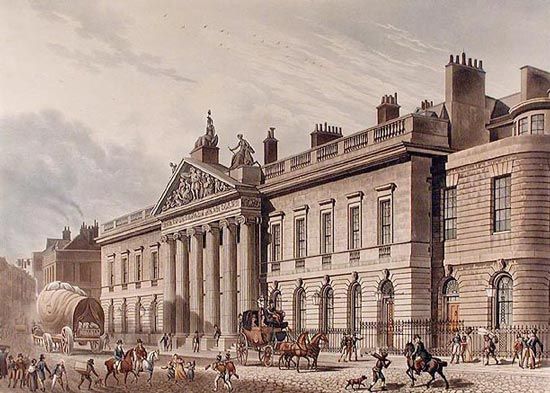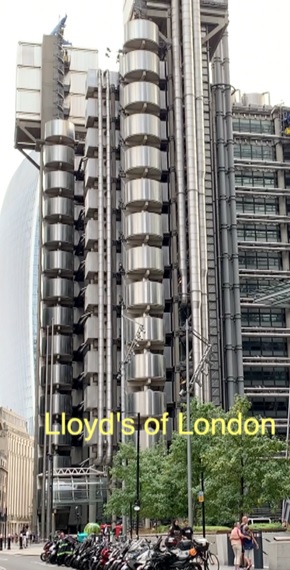
Brittanica
East India Company: 1400s to 1681
By Dr Khalid Siddiqui
Ohio

Since the late 1400s, the Portuguese, Spanish and Dutch were involved in the lucrative spice trade in the East. As a result of this, Spain had become the richest country in Europe.
In 1553, the London merchants founded the world’s first chartered joint-stock company: The Muscovy Company. It traded with Persia via a direct overland route passing through Russia. It sent out six successful voyages before the Ottoman Turks cut off the road in 1580.
The first English attempt to reach East in 1591 via the Cape ended in disaster.
In 1592, the Muscovy Company and two smaller trading companies merged together to form the Levant Company. Its ships would operate in the Mediterranean Sea and were involved in the spice trade with Greece and Aleppo.
In 1599, the Dutch returned from Indonesia with a cargo of 800 tons of pepper, 200 tons of cloves, and large quantities of cinnamon and nutmeg. The voyage made an unprecedented 400 percent profit. As this news became public, the English merchants, explorers and seafarers began discussing the possibility of setting up a company to make similar voyages to buy spices directly from the producers in the East Indies and not, as before, through the Middle Eastern middlemen, who would triple the price by charging hefty commission.
In September 1600, a new trading joint-stock company by the name of East India Company (EIC) was formed. It received the royal charter from Queen Elizabeth I on December 31, 1600. Initially, there were 218 shareholders. The company was exempt from the custom duties for the first six voyages and was given monopoly for fifteen years over the trade in the East Indies. It was granted semi-sovereign privileges to rule territories and raise armies; jurisdiction over all English subjects in Asia; permission to mint money, raise fortifications, make laws, wage war, conduct an independent foreign policy, hold courts, issue punishments and establish English settlements. It was also authorized to indulge in piracy against Spanish and Portuguese ships if necessary. EIC operated from the home of Sir Thomas Smythe, its Governor, in London.
EIC’s fleet of four ships left for its maiden voyage on February 13, 1601, with the cargo of iron, tin and English broadcloth. It was to bring back pepper, nutmeg, cloves, mace, cardamom and other aromatic spices, and jewels from the East Indies. In June 1602, the fleet made it safely to Acheh, and began to negotiate a deal with the Sultan for the spices. However, before a deal could be reached, a loaded Portuguese ship was spotted which was attacked by EIC, and its cargo confiscated. The Company’s fleet arrived back in London on June 1, 1603 carrying 900 tons of pepper, cinnamon and cloves, much of which was taken from the Portuguese boat. The voyage made an impressive 300 percent profit. EIC made a total of 15 expeditions in the next fifteen years. The Company did make some profit but nothing compared to what the Dutch East India Company (VOC) was making. VOC was able to raise more capital, and offered investors a 3,600 per cent dividend. EIC was not able to raise much capital as the richer English nobles, at that time, were investing in Virginia and the New World.
By the early sixteenth century, the Europeans had become used to easy military victories over the other inhabitants of the world. In the 1520s the Spanish had swept away the vast armies of the mighty Aztec Empire in Central and South America in a matter of months. The Dutch without much difficulty took over the Spice Islands of Moluccas (Spice Island), and Java in the East Indies.
On August 28, 1608, Captain William Hawkins of EIC anchored his ship off Surat, India, thus becoming the first commander of an EIC vessel to set foot on Indian soil. At that time India had a population 150 million – 20% of the world’s total. It was producing about 25% of the world’s manufacturing and was the global leader in textiles. Emperor Jahangir, with an income of over £10,000 million, was the richest monarch in the world. The Mughals kept 4 million men under arms. Hawkins made it clear to the Directors of EIC that the force of arms was not an option when dealing with the mighty Mughal empire, and to do trade successfully in India they would need partners and permission instead. It took Hawkins a year to meet Jahangir in Agra. Jahangir showed no interest in any discussion on the subject of trade and sent him back home with the gift of an Armenian Christian wife.
In 1611, EIC opened a trading station in Masulipatnam, the port city of the diamond-rich Sultanate of Golconda – a rival of the Mughals.
EIC then persuaded King James I to send a royal envoy to Mughal India. Thus, Sir Thomas Roe arrived in India in 1615. Roe brought many gifts for Emperor Jahangir including several crates of red wine. He held several inconclusive meetings with the Emperor. After staying three years in India, he was able to obtain a permit from Jahangir to set up a trading station in Surat. Jahangir didn’t think much of Roe as he didn’t even mention his name in his memoirs.
Another station trading with saltpeter (the active ingredient in gunpowder) was established in Patna.
In 1623, the English trading station in the Moluccas (Spice Islands), Indonesia was attacked by VOC troops killing ten Englishmen. At that point EIC directors decided to leave the spice trade in Indonesia to the Dutch and focus, instead, on less competitive and potentially more promising sectors of trade: fine cotton textiles, indigo and chintzes. And the source of these three luxury items was India.
In 1628, EIC built its first fort in India at Madraspatnam (Madras), an area within Vijayanagara Empire, just north of the Portuguese settlement at San Thome. The settlement grew rapidly to a town of 40,000 people. It became the first English colonial town in India with its own civil administration.
The trade in jewels, pepper, textiles and saltpeter soon resulted in better returns for EIC than the Dutch made by trading in aromatic spices in Indonesia. By the 1630s, EIC was importing £105 million worth of pepper from India. The Company’s balance sheet grew increasingly profitable, and the investors from around Europe began to buy EIC stocks.
In 1632, when it was discovered that the Portuguese were building fortifications and dwellings along the River Hugli in Bengal, Emperor Shah Jahan attacked and expelled the Portuguese immediately. Their fortifications were demolished. Four hundred Portuguese were captured and brought to Agra. Some were taken as slaves and the others executed. The Portuguese Viceroy of Goa couldn’t do anything about this action. Closely monitored by EIC, this incident put on hold any ambitions it might have had of establishing a permanent settlement within Mughal India. In 1648, EIC moved to a proper office (East India House) on Leadenhall Street in London. At present, the tall impressive Lloyd’s of London building stands at that location. I happened to visit the site in 2022.

The second biggest English settlement in India came in the hands of EIC via The Crown. On May 11, 1661, King Charles II of England (the king who in 1660 had replaced Richard, son of Oliver Cromwell) married Catherine of Braganza, daughter of King John IV of Portugal. The port of Tangier and the island of Bombay were placed in possession of the British Empire as part of Catherine’s dowry to Charles. (Bombay had been a Portuguese colony since October 25, 1535.) However, the Arabian Sea islands of Salsette, Bassein, Mazagaon, Parel, Worli, Sion, Dharavi and Wadala continued to remain in Portuguese possession. Initially, in London there was much confusion about the location of Bombay, as the map that accompanied Catherine’s marriage contract went missing en route. The Lord High Chancellor believed it to be somewhere near Brazil! It took almost a year to locate Bombay correctly. However, the Portuguese governor of Bombay had not received any instructions from Portugal to hand it over to the British. So, when in September 1662, Sir Abraham Shipman finally arrived with 450 men to claim Bombay for the British, the governor refused to give up control of the island. Shipman’s mission was blocked at gunpoint. The English party was imprisoned in a barren island to the south. It took another three years to get things straightened out.
By 1665, when the island was finally handed over to the British, 336 members of the British party had died from fever and heatstroke. Eventually, Bombay turned out to be the best natural harbor in South Asia. It quickly eclipsed Surat as the main center of EIC operations on the west coast. Later it became EIC’s major naval base in Asia. Thus, Bombay became the first British territory in India where EIC had a permanent settlement. The other two permanent settlements, Madras and Masulipatnam, were within the territories of Vijayanagara Empire and Golconda Sultanate, respectively. Although EIC did have trading stations in Surat, Hougli, Kasimbazar and Patna but, by then, it didn’t have a single permanent settlement within Mughal India. (To be continued)

